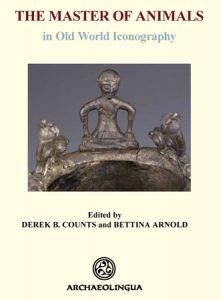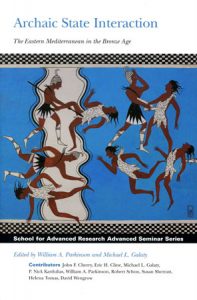ARTICLES | 2010
Variations in the 13C/12C ratios of modern wheat grain, and implications for interpreting data from Bronze Age Assiros Toumba, Greece
Journal of Archaeological Science 36.10 (October 2009): 2224-2233.
Variations in the 13C/12C ratios of wheat grain at different spatial and temporal scales are examined by analysis of modern samples, including harvests of einkorn and durum wheat from Greece, and serve as a guide to interpreting data for Bronze Age grains from Assiros Toumba.Review of A Social Archaeology of Households in Neolithic Greece: an Anthropological Approach
Cambridge Archaeological Journal
Cessford, C., 2010. Review of S.G. Souvatzi, A Social Archaeology of Households in Neolithic Greece: an Anthropological Approach (Cambridge 2008), Cambridge Archaeological Journal 20.1 (February 2010): 135-136.
Review of The LM III Cemetery at Tourloti, Siteia. The ‘Xanthoudidis Master’ and the Octopus Style in East Crete
Προ-ιστορήματα
Merousis, N., 2010. Review of C. Paschalidis, The LM III Cemetery at Tourloti, Siteia. The ‘Xanthoudidis Master’and the Octopus Style in East Crete (Oxford 2009), Προ-ιστορήματα 3 (June) 2010.
‘We don’t talk about Çatalhöyük, we live it’: sustainable archaeological practice through community-based participatory research
World Archaeology 42.3 (2010): 418-429.
Community-based participatory research (CBPR) provides a methodology for engaging descendent and local communities as partners in archaeological research. This article, based on a five-year comparative research project that examines CBPR’s application to archaeology, demonstrates a collaborative model that involves reciprocity, is action based and aims to build community capacity while engaging communities in the process of archaeological research and heritage management.The Minoan lion: Presence and absence on Bronze Age Crete
World Archaeology 42.2 (2010): 273-289.
Animal depictions are frequently treated by archaeologists either as direct reflections of human-animal relations or as symbolic of social realities. This paper offers a different way of conceptualizing animal depictions, as objects which mediate between society and human relationships with non-human animals.Political geography and palatial Crete
Journal of Mediterranean Archaeology 23.1 (2010): 27-54.
The political geography of Crete during the period of the Bronze Age palaces has been a subject of widespread debate, not only with respect to the timing of the island’s move towards greater social and political complexity, but also with regard to the nature of the political institutions and territorial configurations that underpinned palace-centred society, as well as their longer-term stability over the course of the second millennium BC.Location and perspective in the Theran Flotilla Fresco
Journal of Mediterranean Archaeology 23.1 (2010): 3-26.
The Flotilla Fresco from Akrotiri on Thera depicts 14 sea craft, with seven large ships seemingly en route between two landmasses. There are, however, strong arguments against the idea of a long-distance voyage, and instead this study supports the concept of a nautical ceremony.Mycenaean Dimini in context: Investigating regional variability and socioeconomic complexities in Late Bronze Age Greece
American Journal of Archaeology 114.3 (July 2010): 381-401.
Recent excavations at the Mycenaean town of Dimini in the Bay of Volos in Thessaly have led to the interpretation of this site by its excavator as the regional “palatial” administrative center. This article discusses the available archaeological evidence from all three known Mycenaean settlements in the Bay of Volos (Dimini, Kastro and Pefkakia) and considers aspects of settlement pattern, architecture, artifact distribution, burial practices, and craft specialization in those settlements.Swords and Swordsmanship in the Aegean Bronze Age
American Journal of Archaeology 114.3 (July 2010): 403-428.
Warfare and combat are often considered to have played central roles in the characterization of elite identities and the social evolution of Aegean Bronze Age polities of Crete and the Greek mainland. Iconography and mortuary practice provide insights into how warrior identity and violence were materially celebrated.A Return to the Dark Ages? Reply to Thornton et al. 2010
American Journal of Archaeology 114.2 (April 2010): 317-329.
A synthetic theory pointing out the central importance of metallurgy in the emergence of Bronze Age civilizations was recently published in the AJA (‘From Metallurgy to Bronze Age Civilizations: The Synthetic Theory’ [2009] 497-519). In reaction, six well-known authors (Christopher Thornton, Jonathan Golden, David Killick, Vincent Pigott, Thilo Rehren, and Benjamin Roberts) have written a rebuttal devoted mainly to defending the current localizationist paradigm challenged by the synthetic theory.The provenance of some glass ingots from the Uluburun shipwreck
Journal of Archaeological Science 37.2 (February 2010): 295-301.
The discovery of a Late Bronze Age trading vessel at Uluburun near Kaş off the Turkish coast offers exciting possibilities for our understanding of Bronze Age trade. On board the ship was a large consignment of glass ingots that were assumed to originate either from Mesopotamia or Egypt.The Master of Animals in Old World Iconography
Budapest

Archaic State Interaction. The Eastern Mediterranean in the Bronze Age
Santa Fe, New Mexico

Review of The Sanctuary of Hermes and Aphrodite at Syme Viannou IV. Animal Images of Clay. Handmade Figurines; Attachments; Mouldmade Plaques
The Classical Review
Erickson, B., 2010. Review of P. Muhly, The Sanctuary of Hermes and Aphrodite at Syme Viannou IV. Animal Images of Clay. Handmade Figurines; Attachments; Mouldmade Plaques (Athens: Archaeological Society at Athens, 2008), The Classical Review (New Series) 60.2 (September): 553 -555.
